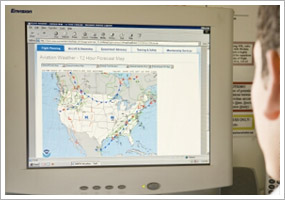| The following stories from the November 21, 2008, edition of AOPA ePilot were provided to AOPA members who expressed an interest in the particular subject areas. Any AOPA member can receive information tailored to their areas of interest by updating their preferences online. TRAINING TIPsGetting ahead
Because weather varies continually, keeping up with the changes and how they are communicated in weather reports and forecasts, will enhance your comprehension and save you time on future flying days. Weather reporting formats sometimes change, as Thomas A. Horne described in "Wx Watch: TAF Tune-up" in the August 2008 AOPA Pilot.
Make it your study routine to obtain practice weather briefings by telephone, writing down the information you receive so that you develop an efficient shorthand. (Sometimes you'll be getting weather in inconvenient locations.) When you're getting weather by computer, select realistic practice routes and destinations to study. Take time to study current notices to airmen (notams). You'll pick up valuable information such as navaid outages, communications frequency changes, runway closures, and temporary changes to airport operations. Sometimes temporary obstructions appear in the vicinity of airports or obstruction lighting goes out of service, as discussed in the Nov. 14 Training Tip.
Take the trouble to look up and interpret the fine details of the information you see. For example, what does the abbreviation PAEW stand for in this recent notam about conditions at DeWitt Field/Old Town Municipal in Old Town, Maine? "Rwy 4/22 AND RWY 12/30 PAEW IN SAFETY AREA."
The abbreviation tells you that personnel and equipment are working in the safety area around the airport's two intersecting runways. PAEW and other common abbreviations used in notams can be looked up in chapter five of the Aeronautical Information Manual.
Quick quiz: What would it tell you about an airport's Taxiway M if you saw "Twy M DCMSND" in a notam? Answer: Taxiway M has been decommissioned. Better not try to use it!
Add the AOPA Air Safety Foundation's WeatherWise Safety Advisor to your weather library for your home study. Many of your questions can be answered there and at AOPA Aviation Weather online.
At last—a plan to keep your training on track when cancellations can't be avoided, or when you just want to learn more about aviation. TRAINING PRODUCTSQref media debuts new line of GPS checklistsGPS receivers are great, but their utility is limited if you don't know your way around the box. And, if you're a renter who changes airplanes from time to time, it can be challenging to keep on top of your avionics. Qref Media recently unveiled a new line of quick reference checklists for GPS and avionics systems. Most aviation systems are covered by available or soon-to-be-released titles for manufacturers such as Avidyne, Bendix/King, Garmin, Honeywell, Lowrance, L-3, and Magellan, according to Qref Media. The checklists are laminated and spiral bound, ranging in size from 27 to 48 pages with tabbed, indexed information. The checklists themselves are 4.25 by 8 inches so as to fit easily on a kneeboard. They are priced from $19.95 to $49.95. For more information, see the Web site. Note: Products listed have not been evaluated by ePilot editors unless otherwise noted. AOPA assumes no responsibility for products or services listed or for claims or actions by manufacturers or vendors. FINAL EXAMQuestion: I am a student pilot about to take my first solo cross-country flight. I was wondering if I am allowed to bring my husband along. Since he is not a pilot, would I still be able to count this as solo flight time?
Answer: Unfortunately, your husband will have to stay at home. FAR 61.89(a) prohibits student pilots from carrying passengers. Once you have earned your private pilot certificate, you can take all of your friends and family flying with you. The only time you can log solo flight time is when you are the sole occupant of the airplane (FAR 61.51).
Got a question for our technical services staff? E-mail to [email protected] or call the Pilot Information Center, 800/872-2672. Don't forget the online archive of "Final Exam" questions and answers, searchable by keyword or topic. |
 If there's no such thing as too much crosswind landing practice in flight training, it's also true that studying aviation weather makes an excellent continuing ground training plan. That's the case even when you have no immediate plans to fly
If there's no such thing as too much crosswind landing practice in flight training, it's also true that studying aviation weather makes an excellent continuing ground training plan. That's the case even when you have no immediate plans to fly

